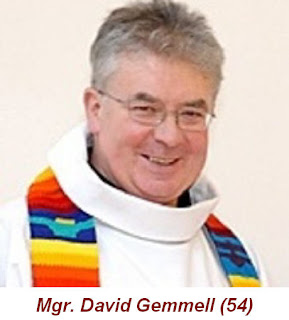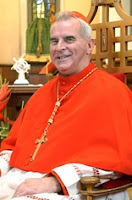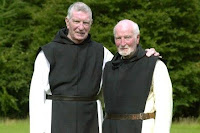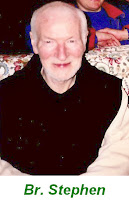 Fr. Chris S.J.
Fr. Chris S.J.
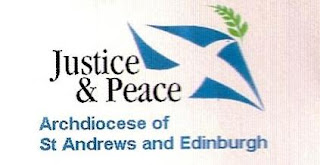
Archdiocese of St Andrews and Edinburgh
8-Mar-08 Lent Day Retreat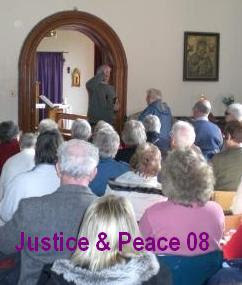
Archdiocesan “Justice and Peace”
directed by Fr. Chris Boles S.J.
Lenten Day of Recollection, Nunraw Abbey, 8 March 2008.
Over 100 persons gathered for this annual event of J&P. Nunraw was the chosen venue this year. Shortage of floor space was resolved by opening the doors of the adjoining Chapel.
11.00 - Welcome, Fr. Donald, Guest-master - Main Lounge
Opening Prayer & First Reflection Session - Fr Boles
Options for the times and places of meeting and prayer made for a varied and rich day of Retreat.
Walking in the grounds
Taize Room
QuietRoom
Chapel
Presentation by Elizabeth Rimmer on the Luchair project in the Abbey Tea Room
1.30 Second Reflection Session - Fr Donald
Options etc
Outdoor Stations of the Cross from Nuraw House to the Abbey – lead by Sr. Jeanette
2.50 Gather in the Abbey Church
3.00 Mass – Fr. Chris. Boles, S.J.
4.00 Departures.

2nd Talk – Fr. Donald, Nunraw Guesthouse.
1. Way of the Cross - Nunraw
Thank you for the joy you bring by entering into this Lent Justice and Peace Day of Retreat. Your successors here tomorrow will actually be the parishioners from the combined Rosewell, Bonnyrigg & Gorebridge Parishes. So if you see the black iron-wrought crosses for the Stations of the Cross, these were first initiated by those people way back. After some years making their annual Way of the Cross on the avenue, they wanted to make it more permanent and so the families sponsored each Cross and commissioned their local blacksmith to forge the Crosses as you see them on your own Pilgrimage today.
The 12th STATION. The sun is now shining so it will be dry. So, for the brave hearted making the Stations, I would like to point out something interesting. The Crosses are very simple, with any figures on them. But on the 12th Station, which of course is the Crucifixion, above the little cross is a large beech tree. If you look closely up at the trunk of the tree there is a natural etching in the bark - appearing like the figure of Christ on the Cross, and over it a kind of canopy – quite remarkable! That is just something in passing. But coming to our journey for Lent, I could even bring you on a mini-pilgrimage to Mt. Sinai.
2. Icon of Christ of Mount Sinai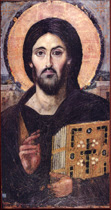
On one wall of this room here is one of the treasures that I brought back with me from the monastery of St. Catherine at the foot of Mt. Sinai. And it is the picture of the CHRIST OF MT. SINAI.
The figure and the detail is quite striking. I have made some reproduction for later. Apart from the numerous commentaries on the details, (e.g. On His right hand. Three fingers touch representing His Divinity, and two fingers are up to symbolize that He is fully God and fully Man, the forefinger bent for His Incarnation. His face is not symmetrical but has a look of dignity and calmness on one side and a different look of arching of the eyebrows causing enlivenment on the other. These dissimilar but complimentary impressions strike a harmony between the Divine and Human Natures of Christ), the commentary that interests me most, if you can look towards the picture, is the Icon of Christ, the Pantocrator, holding out the Word, the Gospel Book. But the most interesting feature for me is the face showing one side in light with the eye open and bright and joyful, whereas the other side of the face is in shadow and, if you look closely, there is actually a tear in Jesus eye. The Icon is expressing suffering and the Passion on the one hand and joy and the Resurrection on the other. Wonderful! And to think how this 6th century Icon has been preserved by the ideal climate and in the lack of the 8th and 9th century’s iconoclastic persecution in that area.
It was something special to bring with me from Mt. Sinai. That was part of the good fortune which brought me to the Holy Land on a Sabbatical. I joined the Scripture Formation Course at the Ecce Homo centre run by the Sisters of Sion in the Via Dolorosa, Jerusalem. The site of the trial by Pontius Pilate, “Behold the Man”. (The 3rd Station at the "Ecce Homo" Arch).
We were taken to Mt. Sinai as a group from the Course and I can remember vividly the climb at Mt. Sinai in the Arabian Desert, elevation some 5500 ft. When we got there we had prepared to rise at 3 o’clock in the morning to begin the climb. Everything that could go wrong will go wrong on these ascents. I was feeling dreadful. If I had not been chivied to keep going by another Abbot who was with us there is no knowing what would have happened to my expedition of a life-time. So we got out at 3 o’clock in the dark. The pilgrims who had gone before us had taken all the camels. Our Guides, on foot, set off at a great pace. Before long I was left with a good Sister from Canada. We were quickly so exhausted that we sat down. And, lo and behold, two camels arrived back from an earlier trip. Undaunted we mounted the camels. That was another hair-raising experience with every bone being shaken and feeling dizzy on the cliff edge path up as the camels seemed to turn up their noses in distain at the shear distance below us. At the destination, other fit members were there before us, giving the final help over the rocks of the summit. Then we watched for the Dawning of the Sun over Mt. Sinai. It was a moving moment. I was privileged to concelebrate and give the Homily at the Mass which followed. (I’ll have to look up the script of that historic Mass).
After a mountain top early breakfast opposite Elijah’s Chapel, the brave ones, including the Sister in Charge, Australian, wanted to tackle the complete summit. The rest of us headed downhill. Before many minutes the whole cavalcade came after us carrying Sister Rosalie. She had broken her leg. The camel drivers were equipped with splints for such eventualities. So that was a sample of the Mt. Sinai experience.
3. Jerusalem
Talking of Justice and Peace, and returning to Jerusalem, I was later traveling to our monastery of Latroun. I just got on a public bus, against which we had been warned because of so many bombings. I got on this bus going to Latroun near Emmaus, the place which commemorates Jesus encountered the two companions on Easter Day. There was an empty seat beside me. This young Israeli stood and looked at me, I was wearing a glorious beard at the time, and he said, “You must be Moses come down from Sinai”. Well I said, “You are not far wrong because I have just come back from Mt. Sinai and we should all be bringing peace”. He sat down and was pleasantly loquacious. His parents had come from Tunisia and chatting away there, he said he was a Jew but not very observant but he could not agree with all the killing. He though everyone, Israeli or Palestinian should live in peace. I thought to myself, well there speaks the voice of the average young person in the street. The same would apply listening to young Palestinians.
And of course the situation in Israel keeps evolving day by day very painfully. It is as we pray for Justice and Peace that the situation in the Middle East becomes very vivid.
4. Camboni Calendar. Thinking of the Christ of Sinai, there is a whole Website on the Expressions on the Face of Christ. There are various images and icons of the face of Christ. A very striking one is a painting used in the Camboni Missionary Calendar for this March.
It is not so grand and symbolic as the Christ of Mt. Sinai or as mystical as the Cross of John of the Cross by Salvador Salve. This one is very different. It portrays Christ draped in a garment of the Resurrection with the marks of the wounds very clear on his hands and feet. Before him are two crosses against a map of South America.
Christ arms are raised out NOT on the Cross, He is now Risen, but He moves to a figure nailed to a large Cross in the guise of plantation worker. Jesus lifts up his arms towards to him as if to embrace and take him down. On the second Cross is a young labouring woman, her hands likewise pierced on the Cross, her face full of suffering.
There is lettering in the background of the painting expressing every aspect of Justice and Peace.
On the one side; Justice, Life, Witness, on the other; Hope, Dignity, Solidarity.
It is a simple theme and its message speaks to our hearts of the countless situations of oppression, exploitation and suffering and of the compassion of Christ’s that we endeavour to share in this time of Lent.
4. Paradise Island or Poverty Island
We can hardly open a Newspaper today without encountering these situations in all their agonizing detail. Just to take a random example. One of my sisters is a Missionary Sister in Australia. She is assigned to a place called Palm Island, an offshore island off Queensland. Good for her you might say, this place of lush vegetation, a stunning tropical paradise. In fact the story is heart rending. In 1918 the Australian Government set up a Aboriginal settlement on the island , uprooting people from their native places and creating a social disaster situation. Paradise Island has become Poverty Island in terms of levels of income, security, quality of life, rates of suicide and alcoholism, and the most telling barometer; 95% unemployment. In 2004 violent riots erupted when a young aboriginal man died in custody of the Australian police.
But at last there is light on the horizon. On the 13 February 2008, following elections in Australia, the new Prime Minister, Mr Kevin Rudd (he of note in the Kyoto agreement) has apologise on behalf of the Goverrnment and the nation to the Aborigine people for the horrors of the Stolen Generations.
One could go on with reference to tragedy in another beautiful country, Kenya. We can thank God that wiser council has prevailed there and another mass pogrom avoided.
5. J&P and Prayer
So as we come together to celebrate a Lent Day of Retreat under the banner of Justice and Peace we cannot BUT feel the overlapping of our thoughts on the Cross
and on the sufferings of our Brothers and sisters in so many situations and places of war, violence and strife.
The fact that you are here in such a large response to the Notice for of the Archdiocesan Justice and Peace Members is an indication of the sense of aptness of entering into the Lent spirit in this active practical way.
It is a meeting point of spirit and body – in both of which, love of God and love of neighbour, we grow in the spirituality, the truth of our Faith on the one hand, and grow in the dept of our understanding of the suffering of our brothers and sisters.
Lent gives us a sense of urgency, not to say enthusiasm, for sharing in the Cross of Christ as it presents itself in every guise.
But to pause there for a moment, let us reflect that we are not going to departmentalize our thoughts or our lives today, not going to pigeonhole the Cross of Jesus in an attic for theology, and our activity for Peace and Justice in some specialised workshop.
Jesus does not know any such division of labour. Facing his critics he states, “Jesus answered them, ‘My Father is still working and I also am working”.
And the fierce reaction to those simple words, “For this reason they were seeking to KILL him, because he was calling God his Father”.
That really set his critics in a rage, calling ‘God his own Father’.
Now to give them their due, his critics DID UNDERSTAND the point, taking the full significance of saying God was his Father. They got the point so powerfully that they wanted to KILL him. I ask you – does it mean all that to each of us – having either to KILL or to Die for the truth of Jesus revelation of Himself, of the Father to me? It is much easier just to meander around the point. Do I feel deeply what Jesus is saying?
But the challenge, the MYSTERY is there. As we proclaim each day at the Consecration of the Mass, MYSTERIUM FIDEI (Let us proclaim the mystery faith).
The word for ‘god’ of the Gospels is not expressed by such words as Prime Mover, or Emanation or Life Force. The language that Jesus uses is that of human relationships lifting our poor minds to the language of divine relationships. Jesus spoke of God as his Father.. And the Father called him his Son: “a voice from heaven said “This is my beloved Son”. (Mt 3:17; 17:5). In World Religions, aspirations to supreme deities, were hard to maintain and tended to evaporate into thin air. They were too remote. More proximate versions of gods filled pantheons of idols.
But for the Christian; God does not evaporate into total generality but become, IN CHRIST, one of ourselves.
Here the Mystery of the Incarnation really TOUCHES us in every sense. “It is what we have heard, what we have seen with our eyes and touched with our hands” (1Jn 1;1) The utter physicality of it is tangible. And even emotionally ‘it plucks our heart-strings’. Even the word Incarnation is incomplete and best uttered in the Biblical language, “Word made flesh”. It is hard if not impossible to keep it all in focus. It would be easy if the Holy Spirit were to come up with some kind of Digital Camera. Instead of Faith we would have some supernatural automatic view finding, automatic depth of focus, and simply point and shoot. It is only by prayer that we can keep our full sense of our spiritual inheritance.
But to go back to the swing of the pendulum in Jesus words. He speaks both of God his Father and of his Father still working as He also is working. It was put very aptly by John Ruskin,“God is a kind Father. He sets us all in the places where he wishes us to be employed, and that employment is truly “Our Father’s Business”. The words of that Victorian Art and Social critic could almost serve as a neat formula, to do our Father’s business. And it suggests the right idea. But how do we fully integrate our understanding of the relationship of the Father with our performance and our working life in practice? Of course we pray every morning and constantly at every level, mostly unconscious I would guess, “Thy will be done”. How do we integrate our prayer and our work.
6. Public Ministry – Inner Ministry
Maybe at this point in Lent we might begin to feel a self conscious anxiety urges us on to additional activities. I was hearing of the very fervent sisters of a Congregation of Sisters in Korea. Vocations and charitable activities are thriving.
Their Mother General, at the end of a Visitation to the Province had a word of warning to them about so many good works and advised them not to become work-alcoholics. Blessed Mother Teresa of Calcutta had something to say on the same topic. Sometimes it takes a Saint or Mystic to make it simple for us.
On the Third Sunday of Lent the Gospel Reading was of that beautiful picture of Jesus meeting the Samaritan woman at the well and telling her that he is thirsty. Those words early in his Public Ministry will be echoed at the end with His words on the Cross, “I thirst”. What we call ‘the Public Ministry’ is equally ‘the Inner Ministry’. That Inner Ministry was well understood by Blessed Mother Teresa of Calcutta when she wrote the letter, her “Spiritual Testament” which she addressed to all her Community.
"Give me a drink"
Jesus’ words “I thirst” (Jn 19,28), written on the wall of all our chapels, are not something from the past but are alive, here and now; they are spoken for you. Do you believe this? If you do, you will understand and feel his presence. Let him be as intimately within you as he is in me; that is the greatest joy you could give me. I will try and help you to understand this but Jesus himself is the only one who can say to you “I thirst!”
Listen to your own name.
And not just once. Every day. If you listen with your heart, you will hear, you will understand. Why did Jesus say: “I thirst”? What is its meaning? It is very difficult to explain it in words… Nevertheless, if you could grasp one, single thing from this letter,
let it be this: “I thirst” is an even more profound word than if Jesus had simply said “I love you”.
So long as you fail to realise, and in a deeply intimate way, that Jesus thirsts for you, you cannot possibly know what it is he wants to be for you, nor what he wants you to be for him.
The heart and soul of the Missionaries of Charity consists entirely in this: the thirst of Jesus’ heart, hidden in the poor.
This alone is at the origin of all that makes up our life. It sets before us both the goal … and the spirit of our Congregation.
To quench the thirst of Jesus living among us is the entire justification for our existence and our exclusive goal. Is there anything more than this we could say about ourselves, namely, that this is our sole motive for living.
I think that is a wonderful Testament of living integration of prayer and works of charity. If prayer is conversation with God then we are also going to talk to him about our activities. Catherine of Genoa had a great saying. It was quoted in our Annual Retreat given by Fr. Gerry Hughes, S.J. Catherine of Genoa said, “God has nothing else to do with God’s time but to look after me”.
7. Conclusion
If I can bring what I have been saying in this half hour full circle, it is as if the script for this Lent Day of Justice and Peace was laid out in the Vatican II’s “The Church in the Modern World”. This morning I came on these words from the Office of Readings under the heading, ‘All human activity will be purified by the Paschal Mystery’.
“The Word of God … assures those who trust in the charity of God that the way of love is open to all men and that the effort to establish a universal brotherhood will not be in vain. This love is not something reserved for important matters, but must be exercised above all in the ordinary circumstances of daily life.
Christ's example in dying for us sinners teaches us that we must carry the cross, which the flesh and the world in conflict on the shoulders of all who seek after justice and peace
Constituted Lord by his resurrection and possessing all authority in heaven and on earth, Christ is now at work in the hearts of men by the power of his Spirit”.
After some years, one of these visitors noticed a strange sight at the 12th Station. Beside this Station of the Crucifixion she notice, on the bulky trunk of the overhanging beech tree some marking on the bark. From the small cross on the road edge, looking at the bowl of the tree there is the distinctive outline of the cross and figure of the Crucified Saviour. It is as if nature has added its own etching to the contribution of the people who set the Crosses.
Compassion in the Passion.


